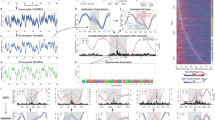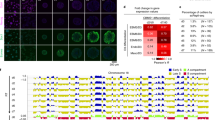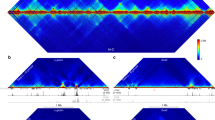Abstract
Profiling chromatin in a particular cell type provides a valuable 'signature' for cell identity and developmental stage. One approach has been to assay and use the timing of DNA replication across a panel of loci as an indicator of chromatin structure. This epigenetic profiling used on pluripotent embryonic stem (ES) cells has reliably distinguished them from cells that have a more restricted lineage potential. Thus, such an approach may become increasingly useful for understanding the molecular basis of pluripotency and lineage induction, especially in the context of stem-cell therapy. Here I describe in detail the DNA replication timing method, whereby unsynchronized cell populations are pulse-labeled with 5-bromo-2′-deoxyuridine (BrdU), fractionated according to cell-cycle stage and the abundance of candidate sequences within newly replicated DNA is determined by PCR. This robust protocol has been used consistently by several laboratories and might offer some advantages over conventional transcription-based profiling for characterizing cell populations. The procedure requires 3–4 d to complete.
This is a preview of subscription content, access via your institution
Access options
Subscribe to this journal
Receive 12 print issues and online access
$259.00 per year
only $21.58 per issue
Buy this article
- Purchase on Springer Link
- Instant access to full article PDF
Prices may be subject to local taxes which are calculated during checkout


Similar content being viewed by others
References
Gilbert, D.M. Replication timing and transcriptional control: beyond cause and effect. Curr. Opin. Cell Biol. 14, 377–383 (2002).
Schubeler, D. et al. Genome-wide DNA replication profile for Drosophila melanogaster: a link between transcription and replication timing. Nat. Genet. 32, 438–442 (2002).
MacAlpine, D.M., Rodriguez, H.K. & Bell, S.P. Coordination of replication and transcription along a Drosophila chromosome. Genes Dev. 18, 3094–3105 (2004).
Woodfine, K. et al. Replication timing of the human genome. Hum. Mol. Genet. 13, 575 (2004).
Vogelauer, M., Rubbi, L., Lucas, I., Brewer, B.J. & Grunstein, M. Histone acetylation regulates the time of replication origin firing. Mol. Cell 10, 1223–1233 (2002).
Lin, C.M., Fu, H., Martinovsky, M., Bouhassira, E. & Aladjem, M.I. Dynamic alterations of replication timing in mammalian cells. Curr. Biol. 13, 1019–1028 (2003).
Azuara, V. et al. Heritable gene silencing in lymphocytes delays chromatid resolution without affecting the timing of DNA replication. Nat. Cell Biol. 5, 668–674 (2003).
Gomez, M. & Brockdorff, N. Heterochromatin on the inactive X chromosome delays replication timing without affecting origin usage. Proc. Natl. Acad. Sci. USA 101, 6923–6928 (2004).
Triolo, T. & Sternglanz, R. Role of interactions between the origin recognition complex and SIR1 in transcriptional silencing. Nature 381, 251–253 (1996).
Goren, A. & Cedar, H. Replicating by the clock. Nat. Rev. Mol. Cell. Biol. 4, 25–32 (2003).
Calza, R.E., Eckhardt, L.A., DelGiudice, T. & Schildkraut, C.L. Changes in gene position are accompanied by a change in time of replication. Cell 36, 689–696 (1984).
Goldman, M.A., Holmquist, G.P., Gray, M.C., Caston, L.A. & Nag, A. Replication timing of genes and middle repetitive sequences. Science 224, 686–692 (1984).
Hatton, K.S. et al. Replication program of active and inactive multigene families in mammalian cells. Mol. Cell. Biol. 8, 2149–2158 (1988).
Dhar, V., Mager, D., Iqbal, A. & Schildkraut, C.L. The coordinate replication of the human beta-globin gene domain reflects its transcriptional activity and nuclease hypersensitivity. Mol. Cell. Biol. 8, 4958–4965 (1988).
Epner, E., Forrester, W.C. & Groudine, M. Asynchronous DNA replication within the human beta-globin gene locus. Proc. Natl. Acad. Sci. USA 85, 8081–8085 (1988).
Taljanidisz, J., Popowski, J. & Sarkar, N. Temporal order of gene replication in Chinese hamster ovary cells. Mol. Cell. Biol. 9, 2881–2889 (1989).
Raghuraman, M.K. et al. Replication dynamics of the yeast genome. Science 294, 115–121 (2001).
Selig, S., Okumura, K., Ward, D.C. & Cedar, H. Delineation of DNA replication time zones by fluorescence in situ hybridization. EMBO J. 11, 1217–1225 (1992).
Bickmore, W.A. & Carothers, A.D. Factors affecting the timing and imprinting of replication on a mammalian chromosome. J. Cell Sci. 108, 2801–2809 (1995).
Boggs, B.A. & Chinault, A.C. Analysis of DNA replication by fluorescence in situ hybridization. Methods 13, 259–270 (1997).
Kitsberg, D. et al. Allele-specific replication timing of imprinted gene regions. Nature 364, 459–463 (1993).
Knoll, J.H., Cheng, S.D. & Lalande, M. Allele specificity of DNA replication timing in the Angelman/Prader- Willi syndrome imprinted chromosomal region. Nat. Genet. 6, 41–46 (1994).
Gunaratne, P.H., Nakao, M., Ledbetter, D.H., Sutcliffe, J.S. & Chinault, A.C. Tissue-specific and allele-specific replication timing control in the imprinted human Prader-Willi syndrome region. Genes Dev. 9, 808–820 (1995).
Simon, I. et al. Asynchronous replication of imprinted genes is established in the gametes and maintained during development. Nature 401, 929–932 (1999).
Chess, A., Simon, I., Cedar, H. & Axel, R. Allelic inactivation regulates olfactory receptor gene expression. Cell 78, 823–834 (1994).
Mostoslavsky, R. et al. Asynchronous replication and allelic exclusion in the immune system. Nature 414, 221–225 (2001).
Hansen, R.S., Canfield, T.K. & Gartler, S.M. Reverse replication timing for the XIST gene in human fibroblasts. Hum. Mol. Genet. 4, 813–820 (1995).
Kawame, H., Gartler, S.M. & Hansen, R.S. Allele-specific replication timing in imprinted domains: absence of asynchrony at several loci. Hum. Mol. Genet. 4, 2287–2293 (1995).
Mesner, L.D., Hamlin, J.L. & Dijkwel, P.A. The matrix attachment region in the Chinese hamster dihydrofolate reductase origin of replication may be required for local chromatid separation. Proc. Natl. Acad. Sci. USA 100, 3281–3286 (2003).
Smith, Z.E. & Higgs, D.R. The pattern of replication at a human telomeric region (16p13.3): its relationship to chromosome structure and gene expression. Hum. Mol. Genet. 8, 1373–1386 (1999).
Gilbert, D.M. Temporal order of replication of Xenopus laevis 5S ribosomal RNA genes in somatic cells. Proc. Natl. Acad. Sci. USA 83, 2924–2928 (1986).
Gilbert, D.M. & Cohen, S.N. Bovine papilloma virus plasmids replicate randomly in mouse fibroblasts throughout S phase of the cell cycle. Cell 50, 59–68 (1987).
Hansen, R.S., Canfield, T.K., Lamb, M.M., Gartler, S.M. & Laird, C.D. Association of fragile X syndrome with delayed replication of the FMR1 gene. Cell 73, 1403–1409 (1993).
Strehl, S., LaSalle, J.M. & Lalande, M. High-resolution analysis of DNA replication domain organization across an R/G-band boundary. Mol. Cell. Biol. 17, 6157–6166 (1997).
Cimbora, D.M. et al. Long-distance control of origin choice and replication timing in the human beta-globin locus are independent of the locus control region. Mol. Cell. Biol. 20, 5581–5591 (2000).
Perry, P. et al. A dynamic switch in the replication timing of key regulator genes in embryonic stem cells upon neural induction. Cell Cycle 3, 1645–1650 (2004).
Hiratani, I., Leskovar, A. & Gilbert, D.M. Differentiation-induced replication-timing changes are restricted to AT-rich/long interspersed nuclear element (LINE)-rich isochores. Proc. Natl. Acad. Sci. USA 101, 16861–16866 (2004).
Azuara, V. et al. Chromatin signatures of pluripotent cell lines. Nat. Cell Biol. 8, 532–538 (2006).
Furst, A., Brown, E.H., Braunstein, J.D. & Schildkraut, C.L. alpha-Globulin sequences are located in a region of early-replicating DNA in murine erythroleukemia cells. Proc. Natl. Acad. Sci. USA 78, 1023–1027 (1981).
Holmquist, G.P. Role of replication time in the control of tissue-specific gene expression. Am. J. Hum. Genet. 40, 151–173 (1987).
Mileham, P. & Brown, S.D. YAC clone contigs covering 5 Mb of a repeat sequence island on the mouse X chromosome. Mamm. Genome 7, 253–261 (1996).
Bernstein, B.E. et al. A bivalent chromatin structure marks key developmental genes in embryonic stem cells. Cell 125, 315–326 (2006).
Boyer, L.A. et al. Polycomb complexes repress developmental regulators in murine embryonic stem cells. Nature 441, 349–353 (2006).
Lee, T.I. et al. Control of developmental regulators by Polycomb in human embryonic stem cells. Cell 125, 301–313 (2006).
Kaganman, I. ESCs keep their options open. Nat. Methods 3, 419 (2006).
Flintoft, L. Poised for action. Nat. Rev. Genet. 7, 410 (2006).
LaSalle, J. & Lalande, M. Flow cytometry and FISH to investigate allele-specific replication timing and homologous association of imprinted chromosomes. Methods Mol. Biol. 181, 181–192 (2001).
Hibbard, M.K., Strehl, S. & Lalande, M. Replication timing of CD4 and CD8 in single-positive peripheral blood lymphocytes. Cell. Immunol. 198, 61–68 (1999).
Donaldson, A.D. Shaping time: chromatin structure and the DNA replication programme. Trends Genet. 21, 444–449 (2005).
Schwaiger, M. & Schubeler, D. A question of timing: emerging links between transcription and replication. Curr. Opin. Genet. Dev. 16, 177–183 (2006).
Sambrook, J., Fritsch, E.F. & Maniatis, T. Molecular Cloning: A Laboratory Manual (Cold Spring Harbor Laboratory Press, Cold Spring Harbor, NY, 1987).
Giulietti, A. et al. An overview of real-time quantitative PCR: applications to quantify cytokine gene expression. Methods 25, 386–401 (2001).
Darzynkiewicz, Z., Juan, G. & Bedner, E. in Current Protocols in Cell Biology (eds. Bonifacino, J. S., Dasso, M., Harford, J. B., Lippincott-Schwartz, J. & Yamada, K.M.) (Wiley, Indianapolis, IN, 1999).
Acknowledgements
I would like to thank Amanda G. Fisher and Matthias Merkenschlager for allowing me to embark on this exciting area of research, Stan Gartler and Scott Hansen for their invaluable help and advice, Helle F. Jørgensen, Olivia Alder and Marie-Laure Caparros for reading this manuscript and Graham Reed for photographic assistance. This work was supported by the Medical Research Council, UK, Imperial College London, UK and by a MRC Collaborative Career Development Fellowship in Stem Cell Research funded by the Parkinson's disease Society (V.A.).
Author information
Authors and Affiliations
Corresponding author
Ethics declarations
Competing interests
The author declares no competing financial interests.
Rights and permissions
About this article
Cite this article
Azuara, V. Profiling of DNA replication timing in unsynchronized cell populations. Nat Protoc 1, 2171–2177 (2006). https://doi.org/10.1038/nprot.2006.353
Published:
Issue Date:
DOI: https://doi.org/10.1038/nprot.2006.353
This article is cited by
-
YM155 potently kills acute lymphoblastic leukemia cells through activation of the DNA damage pathway
Journal of Hematology & Oncology (2015)
-
Cell cycle staging of individual cells by fluorescence microscopy
Nature Protocols (2015)
-
Global mapping of H3K4me3 and H3K27me3 reveals chromatin state-based regulation of human monocyte-derived dendritic cells in different environments
Genes & Immunity (2012)
-
Targeting survivin and p53 in pediatric acute lymphoblastic leukemia
Leukemia (2012)
-
Reduced histone biosynthesis and chromatin changes arising from a damage signal at telomeres
Nature Structural & Molecular Biology (2010)
Comments
By submitting a comment you agree to abide by our Terms and Community Guidelines. If you find something abusive or that does not comply with our terms or guidelines please flag it as inappropriate.



